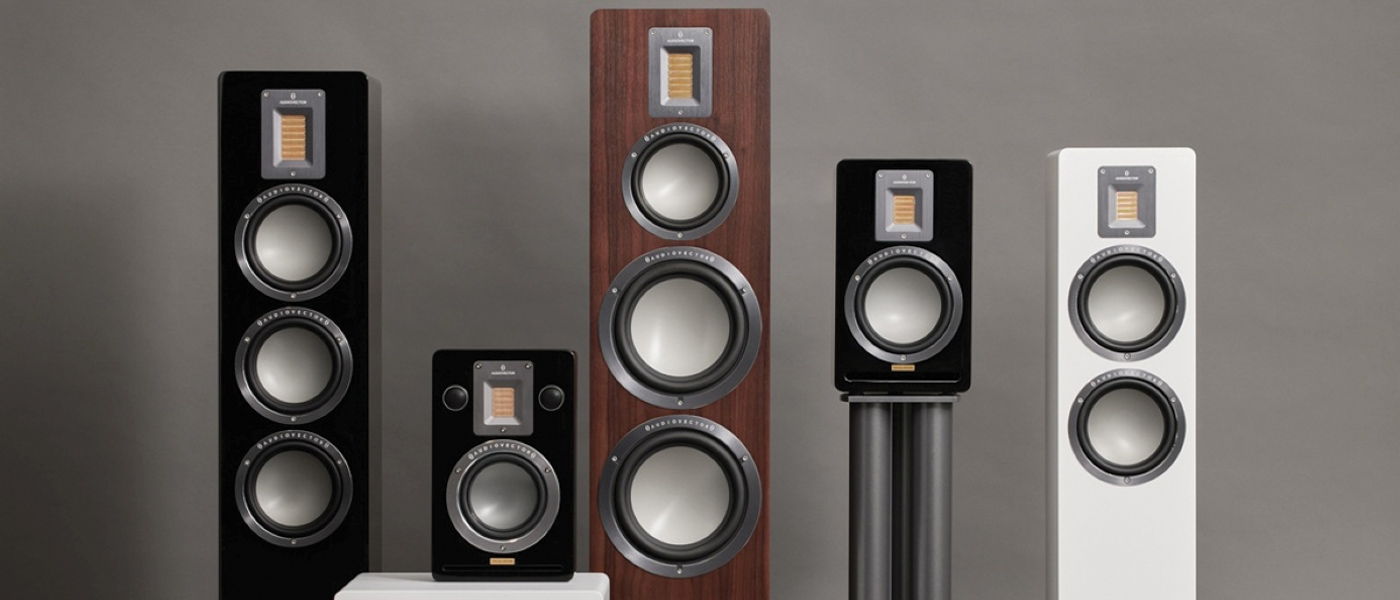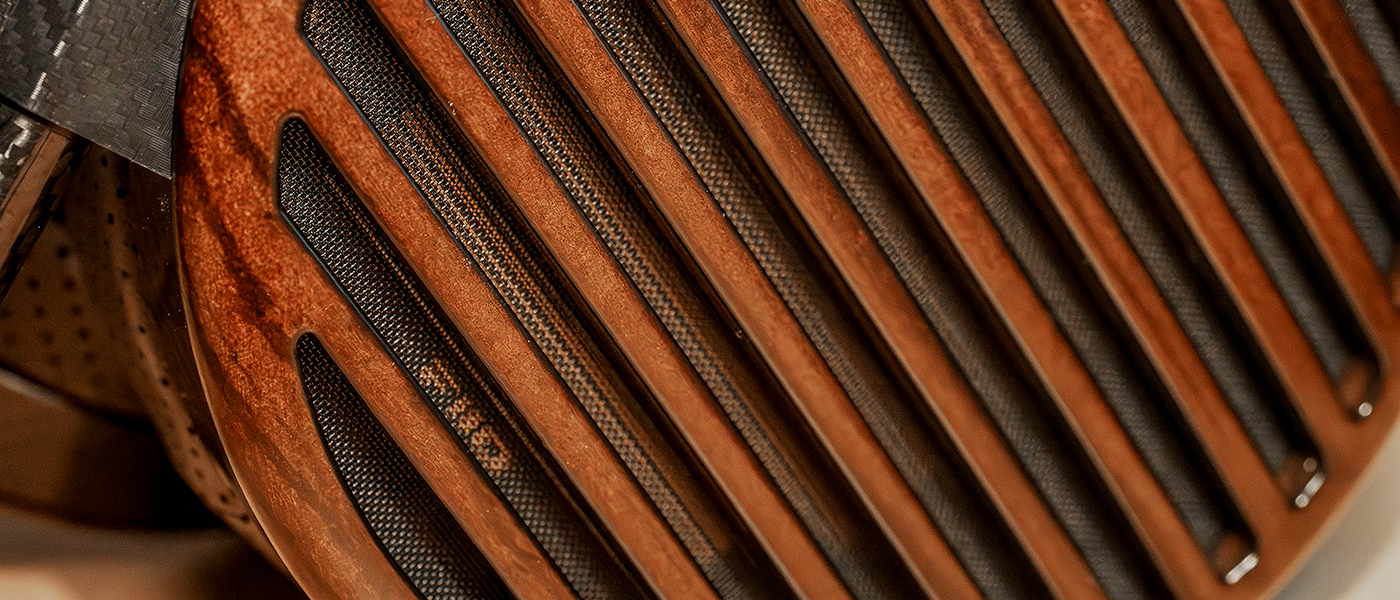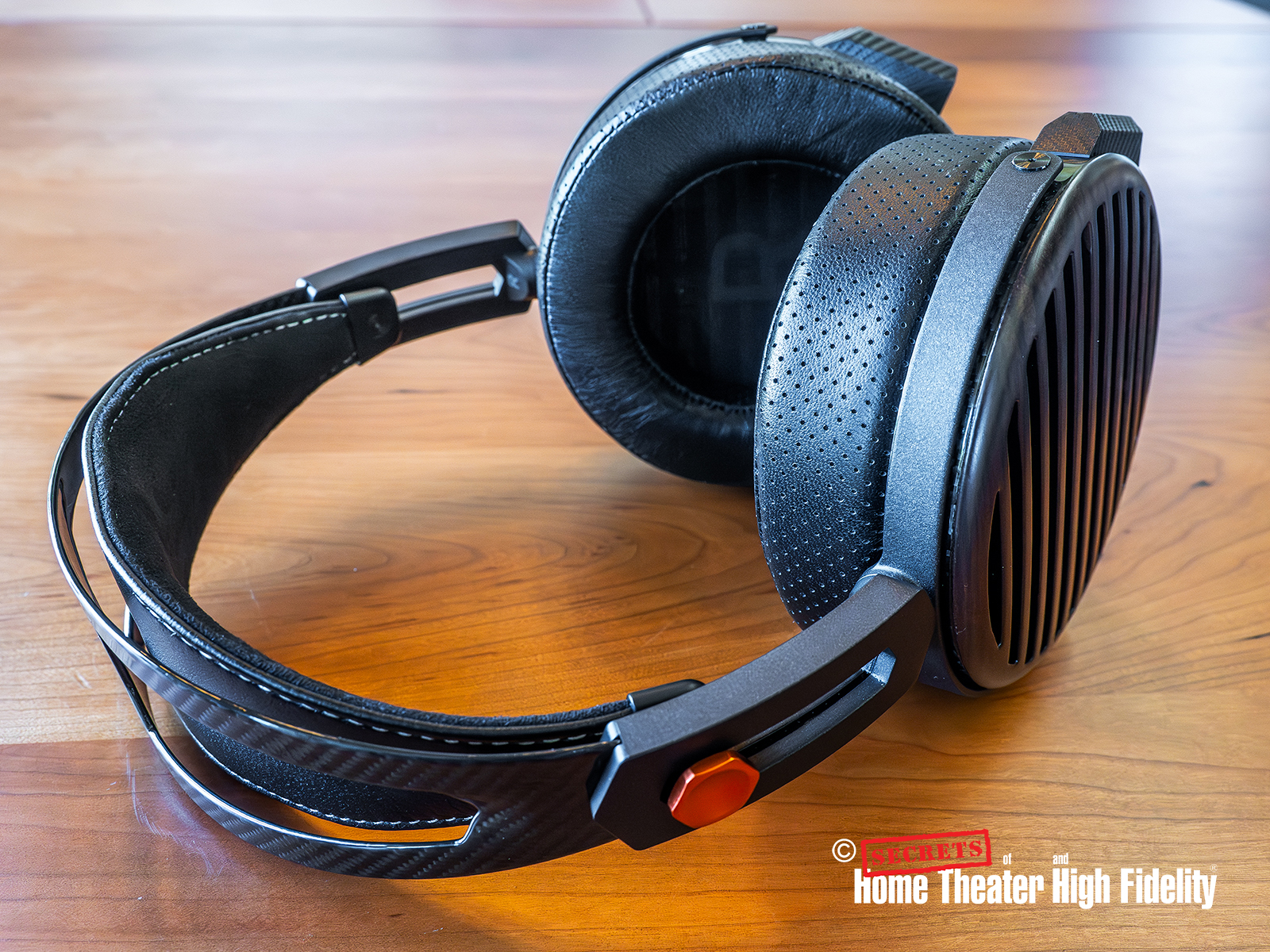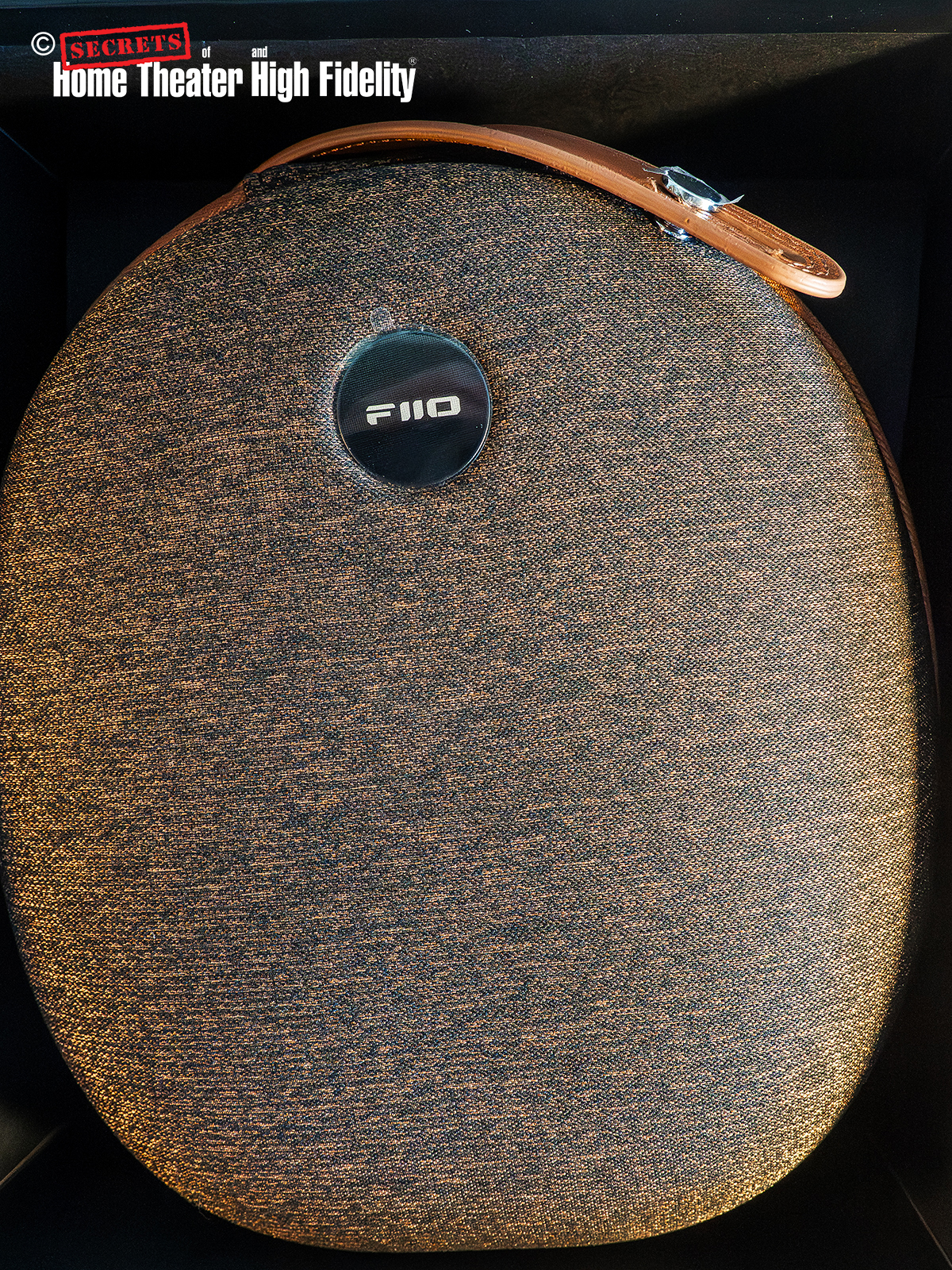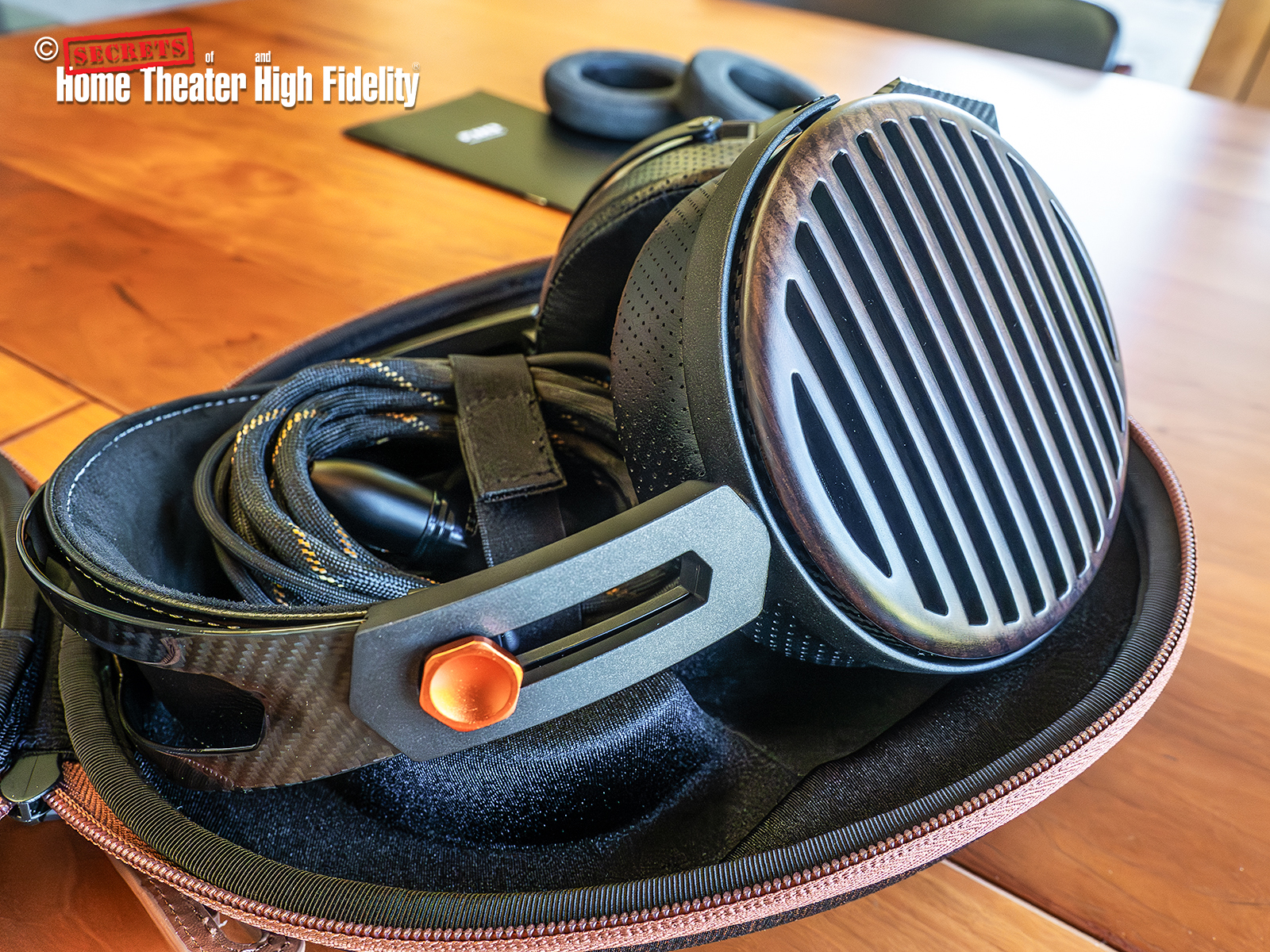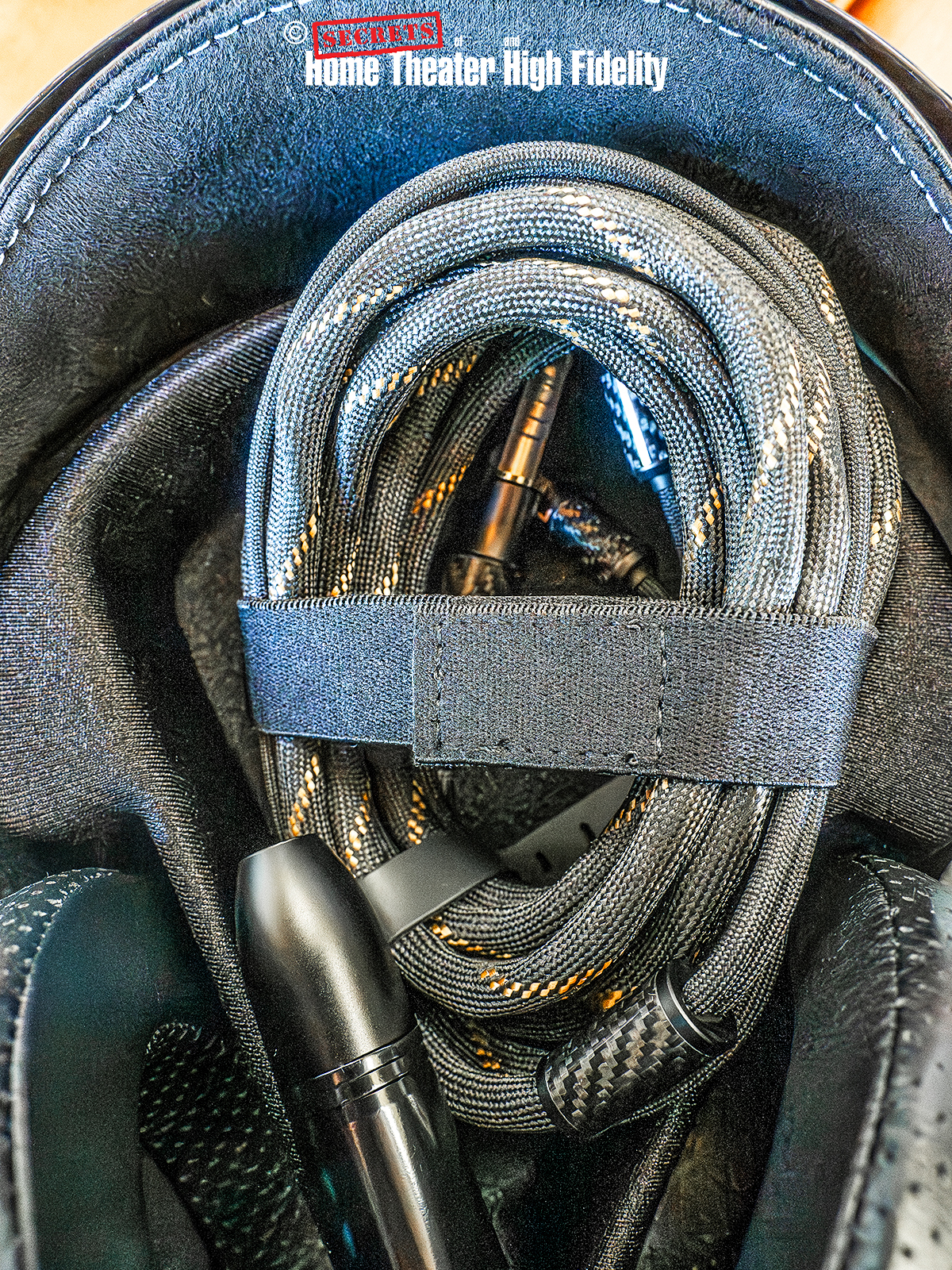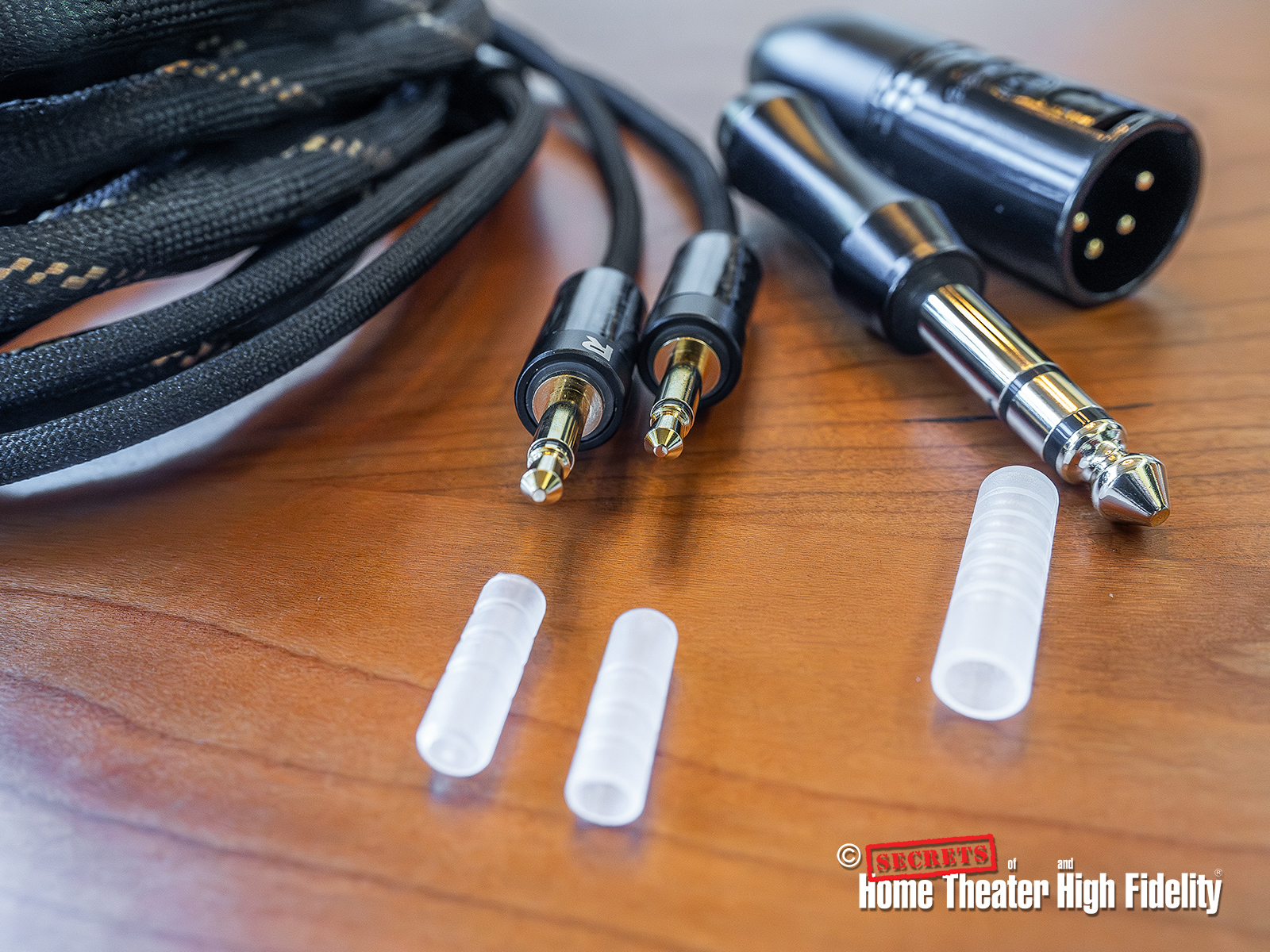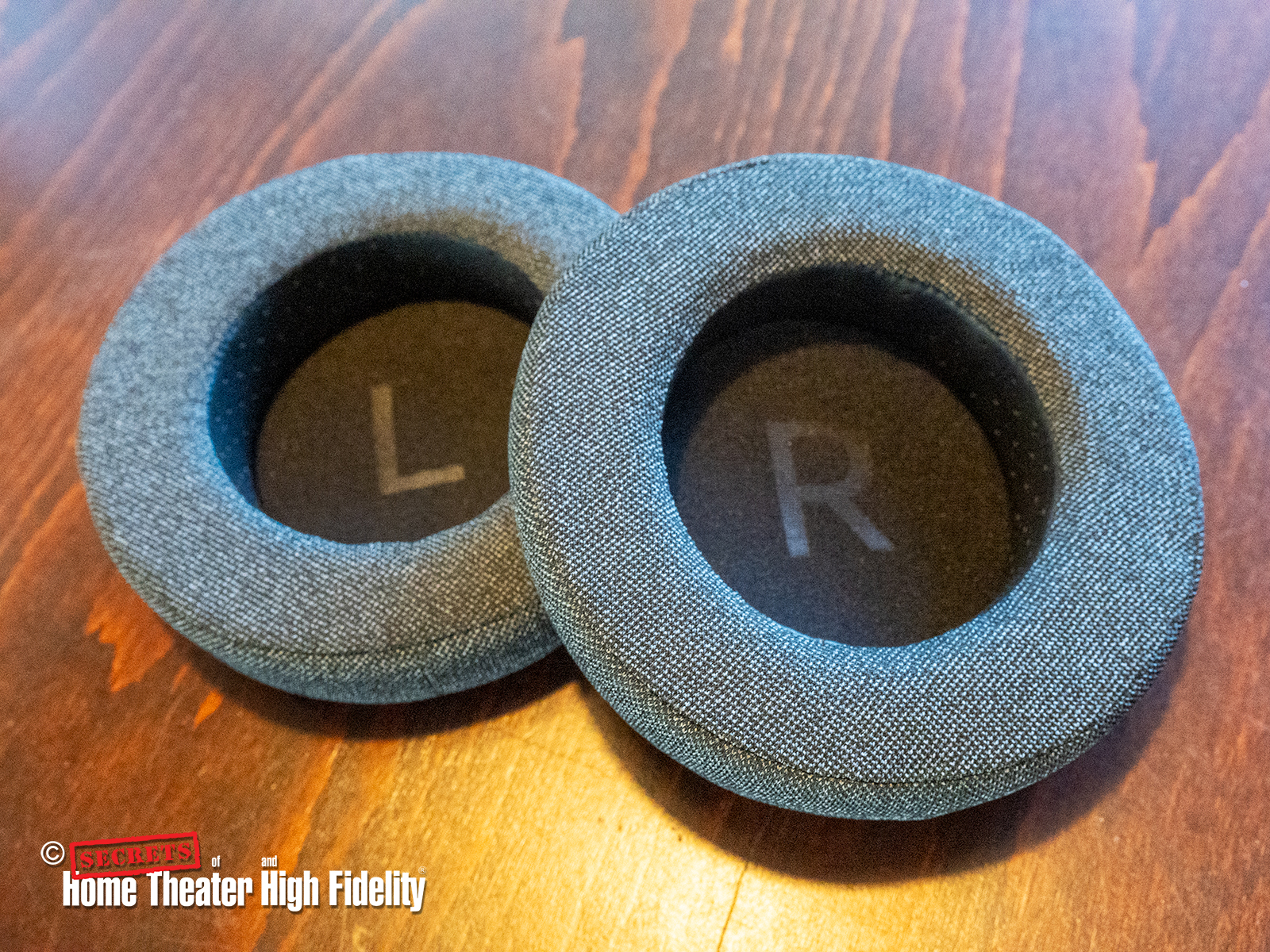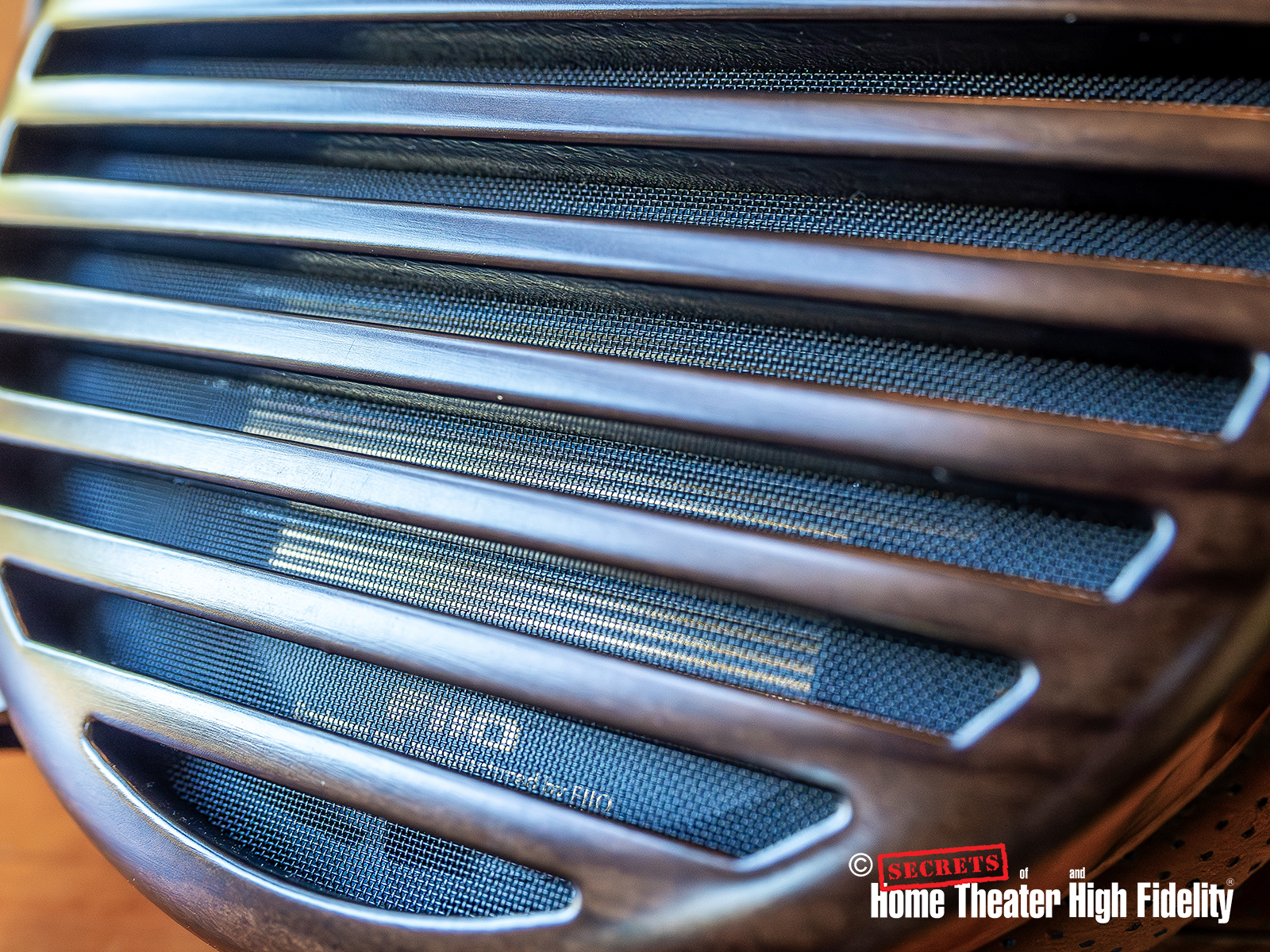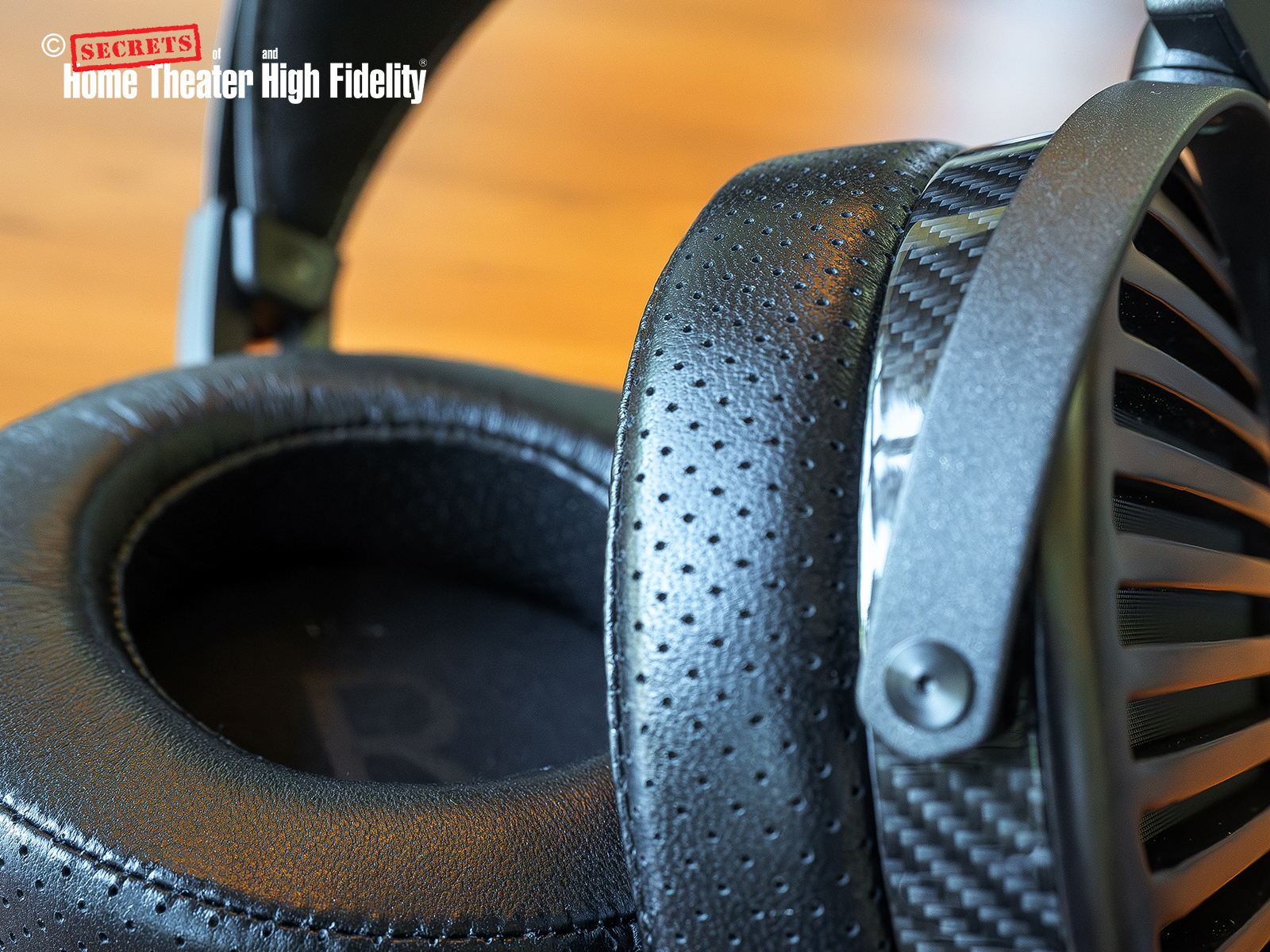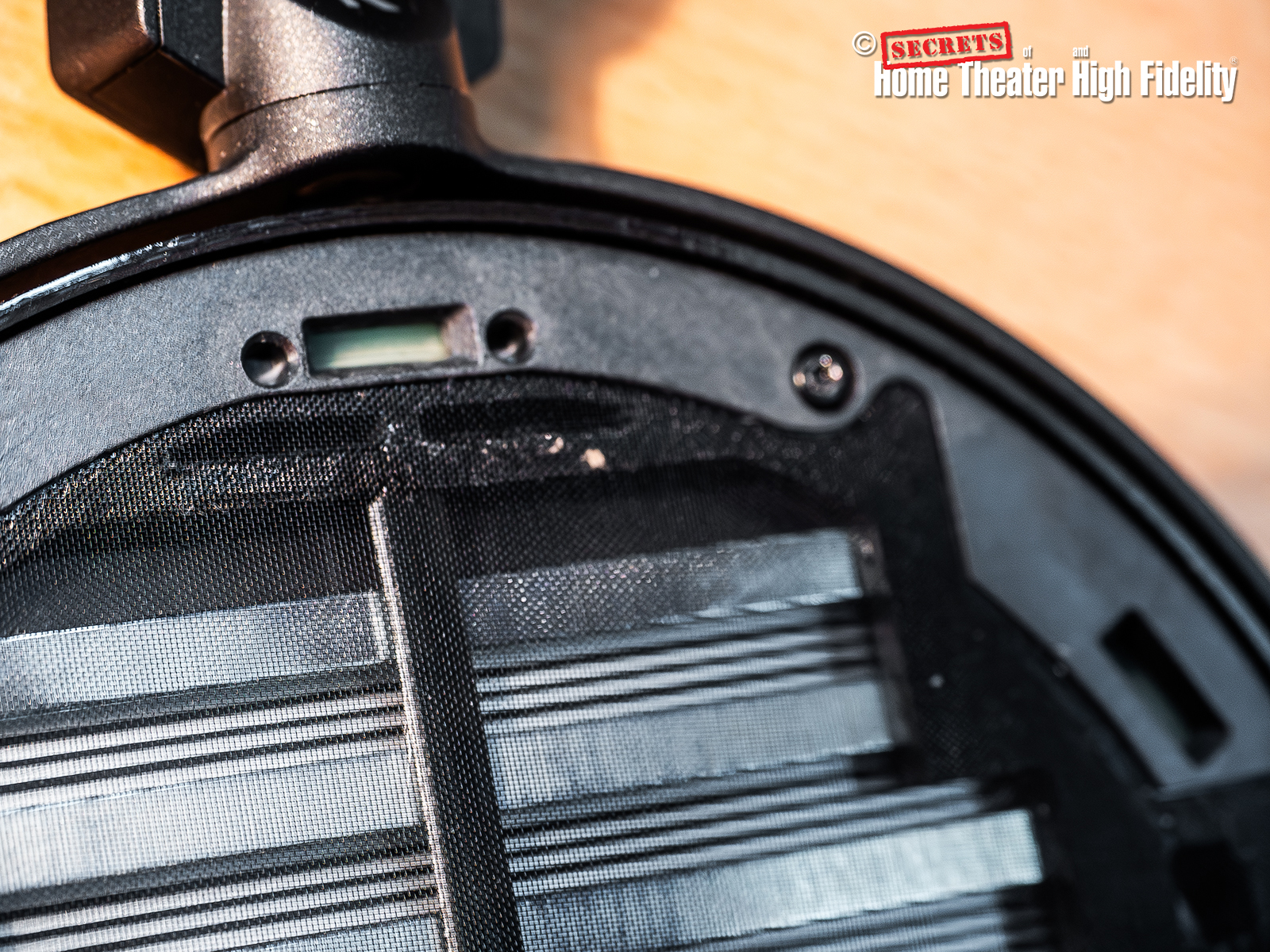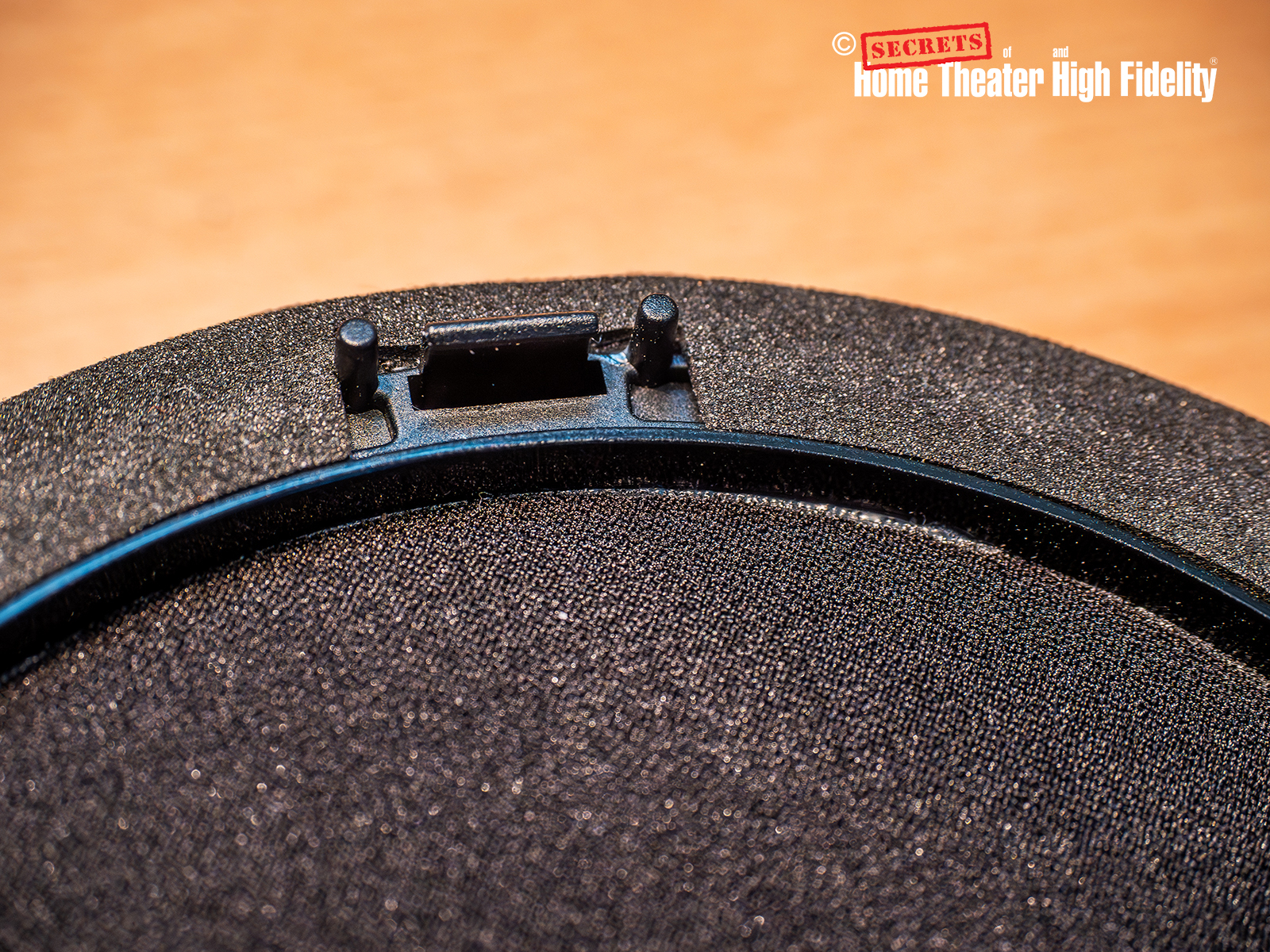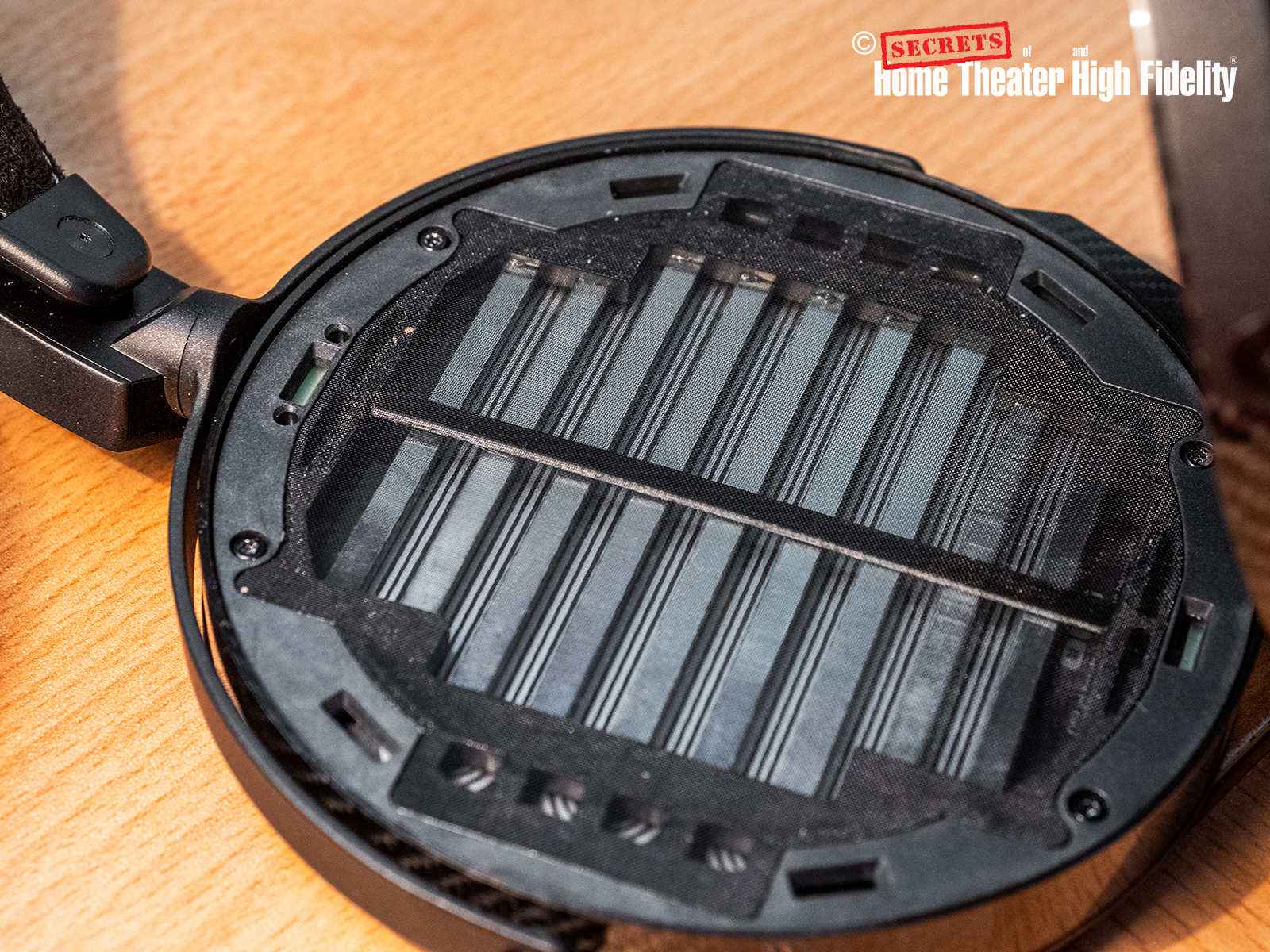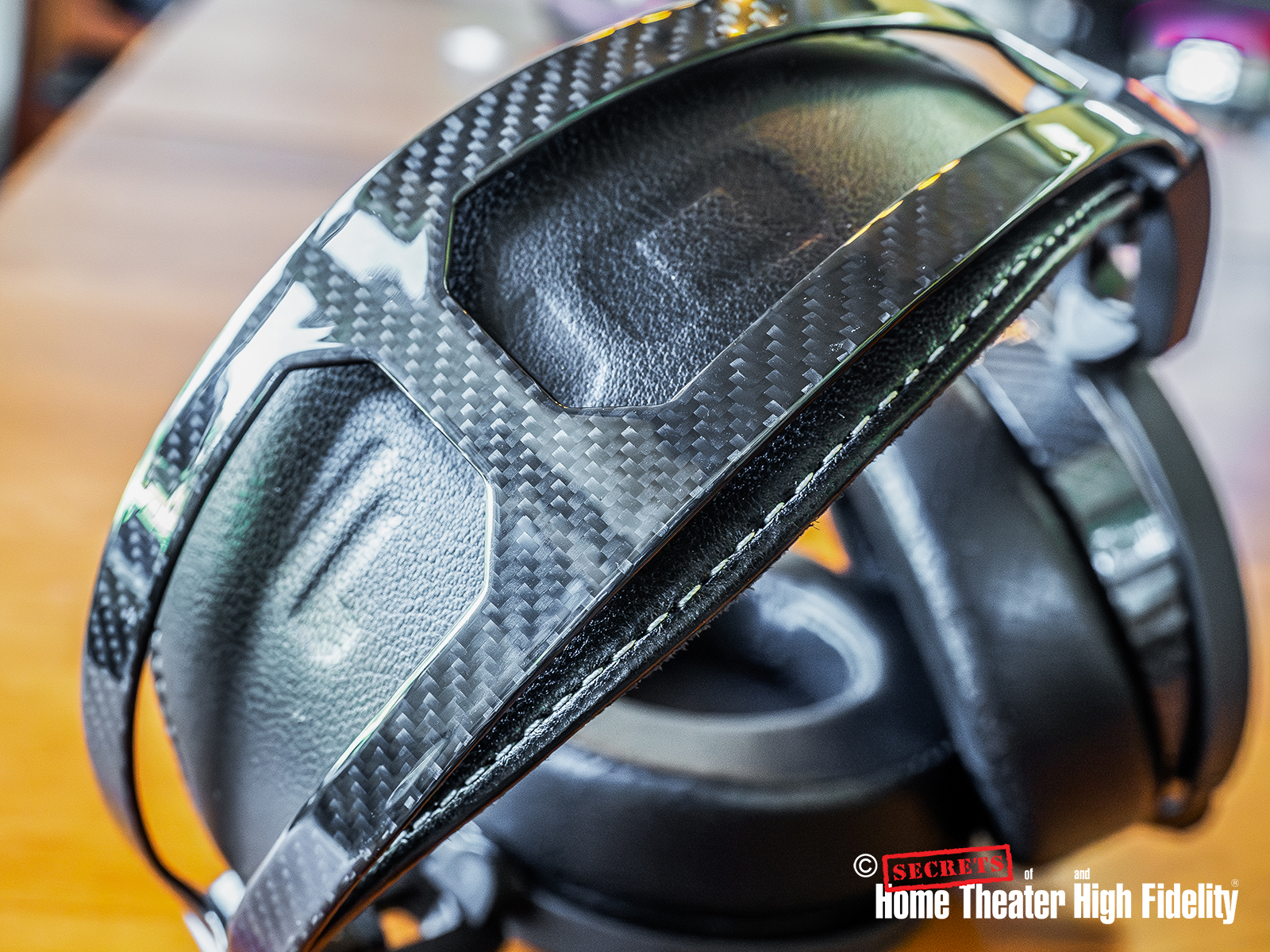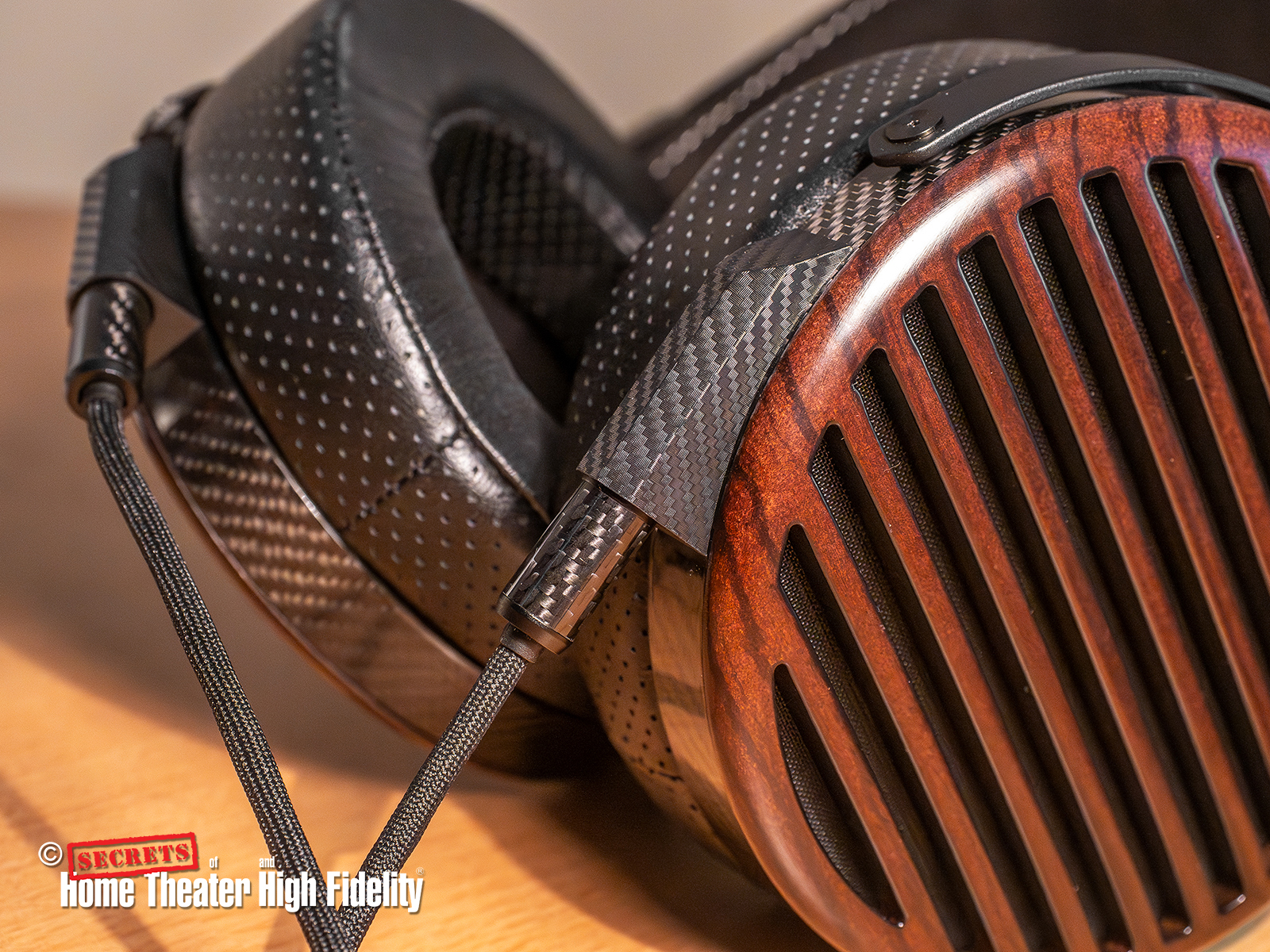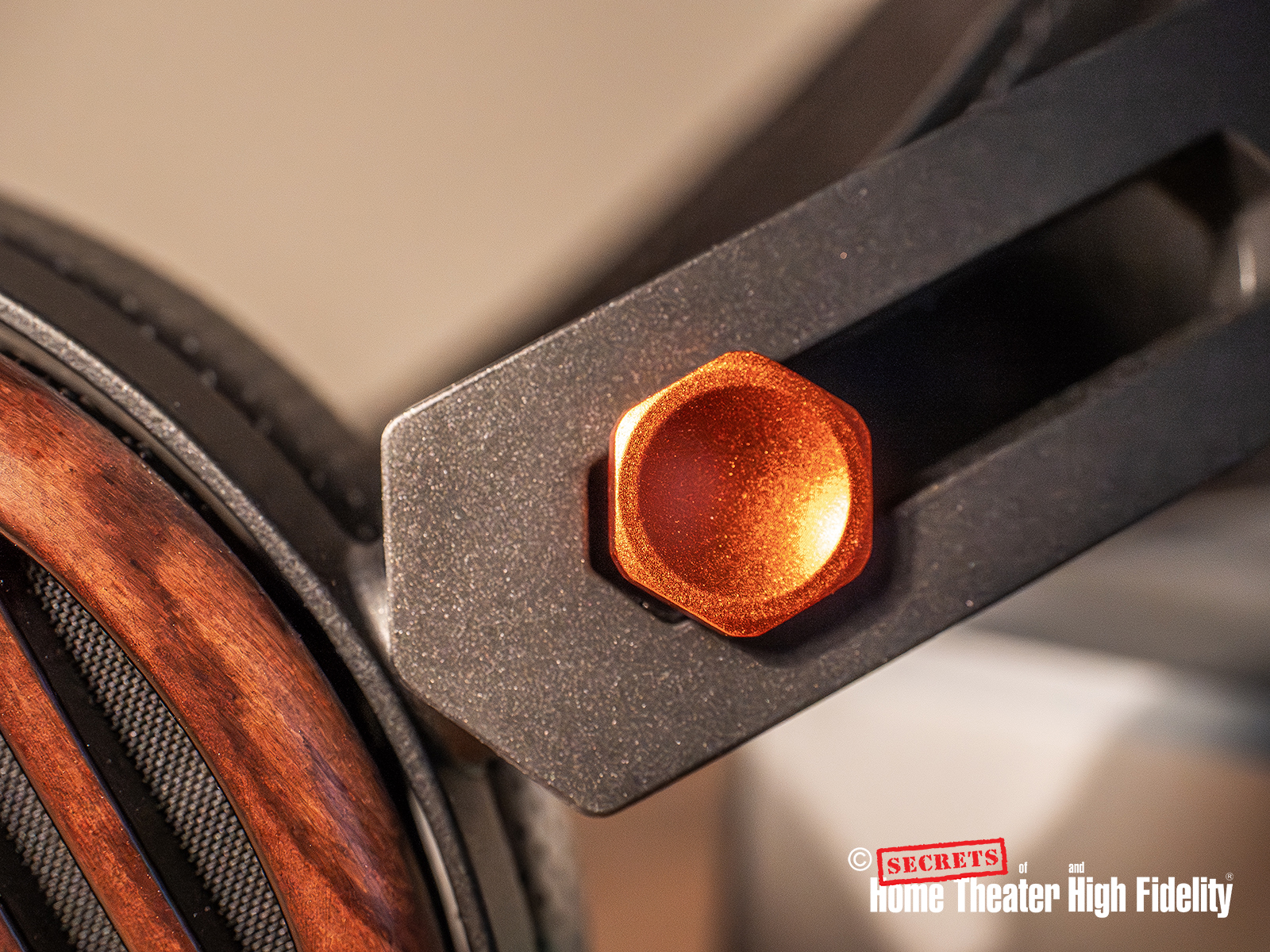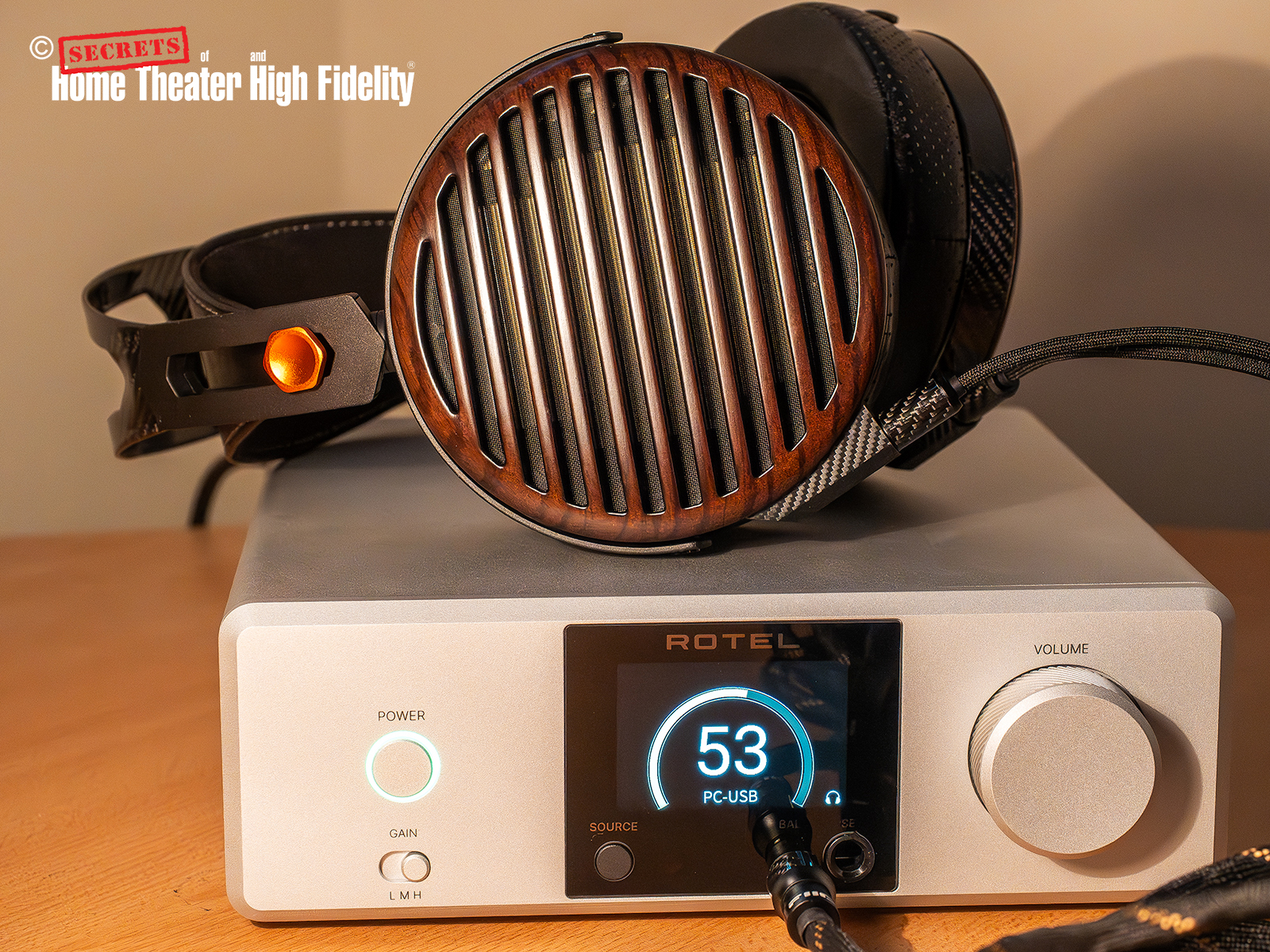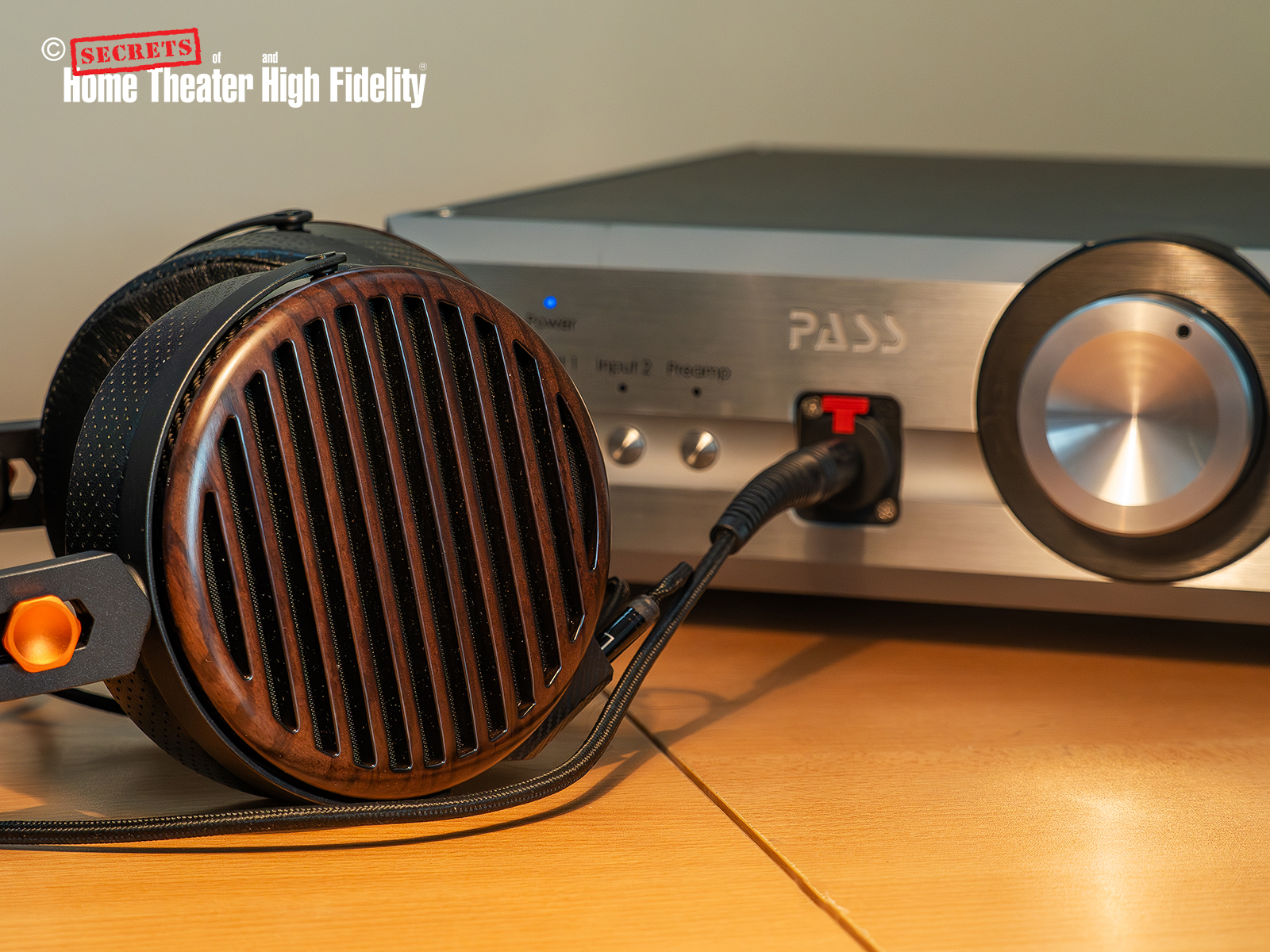The introduction of the FT7 open-back planar headphone is their first entry into the “flagship” headphone world. Built with Real Zebra wood grills, lambskin pads, gold and pure silver layer drivers, and composite construction, all make a statement that they are here to compete with the premium headphone market. With a price that reflects FiiO’s bold challenge to products that cost considerably more, they have shaken up the market.
The FiiO FT7 are handsome. Rich Zebra wood grills reveal the gleam of the gold and silver drivers underneath. Surrounded by a black carbon fiber and metal housing and black perforated lambskin pads, the FT7 headphones radiate a quiet message that these are built to last. The included XLR-4 pin balanced and 6.35mm single-ended connector tips give the single balanced 4.4mm cable the flexibility to work with almost any headphone amplifier.
Though the FT7 sports a full-size 106mm planar magnetic driver and has 18 high-performance N52 neodymium magnets, it is fairly easy to drive at 25Ω and 94dB.
This is a fun, punchy, and detailed headphone that those folks who love their rock and roll will enjoy.
FiiO FT7 Open-Back Planar Headphone
- Large, deep ear cups.
- Choice of two easily swappable lambskin leather and fabric earpads.
- Full-size planar drivers provide a large soundstage.
- Three different connector choices are included for the 10 ft. long, monocrystalline copper cable.
- Warm mids and strong punchy bass. Warm to neutral overall.
- Easy to drive, can be enjoyed on portable DACS and DAPs.
- Carbon fiber construction is lightweight and sturdy.
- Even with large magnets and robust construction, the FT7 are comfortable and light.
- Affordable for a flagship headphone.
FiiO is a Chinese audio company founded in 2007 by senior engineers who were formerly with OPPO Digital, a U.S.-based company that produced high-end audio and video equipment. Their products include Hi-resolution music players, headphone amplifiers and DACS, headphones/IEMs, and home audio gear.
I met the team from FiiO at CanJam 2023. At the time, I was looking for portable headphone DACs and was told I should check out the FiiO table. I wasn’t yet familiar with the FiiO brand. I found a table covered with the largest collection of various portable and desktop headphone amplifiers I had seen at the show. Not only headphone amps and DACS, but headphones as well. Thirty minutes later, I was still there, because not only were there every kind of portable device to explore, but also headphones that really sounded great. And when I asked to see the prices, I thought there was a mistake in translation from Chinese to English and currency exchange rates because these products were the least expensive of anything I had seen at CanJam. I don’t know how they do it, but FiiO produces high-quality products at astonishingly affordable prices.
FiiO conducts extensive R&D, and the design and testing that were involved with the two-year development of the FT7 was interesting. They started out with the idea of making the FT7 either a planar or a dynamic driver design. They worked on both designs simultaneously. Both designs performed well, but recent developments in thin diaphragms gave them the missing piece in developing a large but light planar magnetic headphone. As for the dynamic driver version? It may be reserved for future high-end products.
106mm proprietary planar magnetic driver.
1μm ultra-thin PET film diaphragm with dual-layer 24k gold and pure silver traces.
Magnetic structure:
symmetrical push-pull with 18 N52 high-performance magnets per driver.
Frequency response:
5Hz-40kHz.
Impedance:
25Ω ± 15%.
Sensitivity:
94dB/mW @1kHz/110dB/Vrms @1kHz.
Weight:
approximately 427g (excluding cable).
Cable:
6N liquid nitrogen frozen monocrystalline copper.
Cable connector:
dual 3.5mm TS.
Audio plug:
4.4mm balanced, plus 6.35mm and 4-pin XLR adaptors included.
Earpads:
perforated genuine lambskin leather and swappable breathable fabric pads.
Open-back design.
MSRP:
$699.99
Website:
Company:
SECRETS Tags:
FiiO, FT7, Open-Back, Planar, Open-Back Planar, Headphone
Secrets Sponsor
The FiiO FT7 arrived packed tightly in a golden-brown tweedy carrying case. The hard-sided case is medium in size and still fairly large for carrying the headphones for travel, but a nice size to fit on a shelf.
Along with the FT7 was the very tightly wrapped 10ft cable (I almost expected it to spring out of the case when I untied it), the manual, and the two additional connectors: a 6.35mm single-ended, and a 4-pin XLR. Also included were a pair of fabric-covered ear pads.
The FT7 are handsome in an understated, burnished wood and leather kind of beauty. The carbon fiber and metal housing and headband support were a choice FiiO made for keeping the headphones light but strong. The West African zebra wood grills are aligned with the magnets underneath to minimize refraction. Glints of the gold diaphragm behind the zebra wood add to the elegant look.
The lambskin pads, which come attached to the headphones, are sumptuous. The black perforated leather is soft, and the round earcups are deep enough for most ears to fit comfortably. In addition, there are fabric pads that are easy to swap with the leather pads that provide a different sound signature.
The R&D for the drivers involved testing various metals. Most companies don’t share their R&D, but FiiO does. In FiiO’s development of the FT7, several materials were tried out for the tracers in the diaphragm.
Full gold plating: though beautiful, and theoretically improving mass uniformity and internal damping, gold’s weight caused rapid high-frequency roll-off, even though it provided mid-bass improvements.
Copper-plated coils: similar weight issues caused high-frequency loss, as well as a susceptibility to oxidation, thus proving too unstable for long-term use.
Pure silver coils: provided improved high-frequency details but reduced both lateral and vertical soundstage dimensions.
Multi-coil design: though intended to increase the area of the driver and reduce vibration, it increased impedance while making the sound thinner.
Reinforcement rib design: An attempt to reduce coating weight and modify material properties, but high-frequency attenuation remained problematic due to excessive mass.
What FiiO found that produced the results they were looking for was gold plus silver in their multi-layer voice coils.
Their R&D also resulted in finding the combination of magnets that provided the power needed to drive the gold and silver traces. High-performance neodymium was chosen for the strength-to-weight ratio, and a total of 18 magnets, with 9 on each side of the diaphragm, was the result. The push-pull forces of the magnets led to the need to find materials for the housing strong enough to withstand the forces, while staying light. Carbon fiber was the material chosen, and it contributes to the handsome look of the design as well as the long-term durability.
The FT7 headphones come with two sets of pads that shape the sonic characteristics. According to FiiO, the lambskin pads feature more treble, detail, and soundstage. The fabric pads tame the brightness of the treble and provide a more neutral sound with emphasis on the vocals and bass. The pads are easy to remove and replace. Removing the pads is simply a matter of gently tugging under the hard plastic edge of the pad. Attaching the pads is a matter of lining up the two holes on the plastic side of the pads with the two pegs at the top of the housing. All the remaining pegs and holes snap into place with gentle pressure around the edges of the pads.
The headband is both carbon fiber for the housing and the band is soft metal sandwiched between two layers of leather, which is designed to mold to the user’s head shape over time. It was comfortable, though the leather band is rather stiff, and some may find it will take some bending to find the best placement to avoid hotspots. The carbon fiber housing for the recessed jacks is quite prominent on the bottom front of the ear cups. One caution about them, since they are recessed, a little force is good when inserting a cable, as they need to go fairly deep to engage fully. My preferred jack was the 4.4mm and the 4-pin XLR, compared to the 6.35mm single-ended jack. No surprise there, I suppose, as there is more volume available through the balanced connectors, and the FT7 seemed to kick into high gear with more volume.
The headband adjustment slider was rather odd and my least favorite part of the FT7. Number one…why the heck did they make it a shiny burnt-orange metal hexagon with sharp points? It was stiff and difficult to move. In my case, I need the knob all the way at the bottom of the slider for my smaller head, so it stays in place, but if someone with a bigger head needs to move it, I’m not sure it will stay in position. And that color? I feel they are mixing their metaphors…elegant understatement with a playful orange knob. I think the color could work on a more colorful consumer-level headphone, but not the otherwise beautiful FT7.
This is where it gets interesting. I’ve never really believed the DAC/amplifier matters until testing this headphone on several different DAC/Amps. I chose the Topping DX7 Pro as my first choice, with the thought that it represents what many people would be using. It’s a popular DAC/Amp and does many things well. However, on some recordings, it was harsh and emphasized the treble. This happened on this headphone combination. I was listening to a poorly recorded song (Iron Butterfly, In-A-Gadda-Da-Vida, the 2006 remaster…great drumming solo!). I had to take off the headphones as the treble took on a broken glass sharpness that hurt my ears. I played the same song, but I used the Rotel DX-3. It was a different experience. It is still a trebly song, but the tones came into balance, and the edges got rounded off beautifully. Finally, I fired up the Pass Labs HPA-1 amplifier and used the Topping DX7 as the DAC. Wow, how lush and warm the headphones sounded.
Finally, I checked out how the FT7 would play with a portable DAC/Amp. I chose the iFi Go bar Kensei. It was very enjoyable, and the Kensei had no trouble driving the FT7 with plenty of volume and dynamics.
What this test showed me is that these headphones are somewhat picky as to how they are powered, at least on some songs. On most music, they performed very well regardless of the amplifier.
The cable came with a 4.4mm balanced connector, a 6.35mm single-ended connector, and 4-pin XLR adaptor tips. I think the 4.4mm was a good choice, as I think the Pentaconn connector is being used more, and I think it is probably becoming the connector of choice. Though the adaptor tips make this single cable very adaptable, the two tips extend the cable horizontally by a few inches, which could be problematic where spaces are tight.
The FiiO FT7 is a fun, lively headphone. It does most things very well. It is a fast, responsive headphone, as planar magnetic headphones tend to be. In fact, it shows off the best of planar characteristics. Crisp details, precise spatial imaging, wide, open soundstage. The FiiO FT7 hits bass notes with authority and punch, though tending to tight, controlled bass vs big, warm, booming bass. However, when listening to hip hop, it hit those bass notes with force and depth with the best of them. At times, the mids and treble can sound a little thin and lack body and warmth, which I found a bit jarring at times, as it was in contrast with the warmth of the lower tones.
The lambskin pads were my choice for the most part. They provided the best spatial width and precise placement. They felt better on my ears. There was a tendency to go a bit too far into the treble, however, and the overall feel was thinner with less body compared to the fabric pads. The fabric pads were good at rounding off the sharp highs. Though they warmed up the overall feel and enriched the bass, they did it at the cost of sparkling detail and soundstage, and didn’t feel as comfortable for long listening.

Melody Gardot, Sunset in The Blue (Deluxe Version), 24-bit, 96 kHz-Stereo, Qobuz
Melody Gardot is a jazz singer known for her dusky yet delicate vocals, who blends jazz, Latin, and Brazilian music. She has five Top Ten Billboard Traditional Jazz albums. Early in her career, she suffered a life-threatening bicycle accident, but her love of singing and determination to keep singing carried her through rehabilitation, and she returned to the studio. She now wears sunglasses in bright light due to the injury to her eyes, but, like Roy Orbison, she manages to look cool and mysterious.
She co-wrote “Little Something” with Sting and his guitarist Dominic Miller. This lilting, bossa nova-esque jazz song highlights the Spanish guitar playing of Dominic Miller and the legendary reggae-influenced drumming of Stewart Copeland, the drummer for the Police. It is fast, light, and playful. The FT7 kept right up, capturing every note and beat. This song highlights the clarity that the FT7 headphones do so easily. Sting and Melody’s “dialogue” singing was voice-forward and intimate. I thought the FT7 did a good job with the overall timbre.

The Dave Brubeck Quartet, Time Outtakes (Previously Unreleased Takes from the Original 1959 Sessions) Hi-Res 24-Bit, 44kHz-Stereo, Qobuz
We all know “Take Five”. We grew up with it; it is ubiquitous, and though a fabulous recording, it is easy to dismiss it as “been there, done that”. Well, this recording of the unreleased takes of that recording session is a wonder. The sessions are raw, and nothing is held back. The musicians have free rein. It is big and wild. I would have loved to have been there to experience the electricity in the studio. My focus on this recording was on the drumming of Joe Morello, who played with the quartet from 1956 to 1968, and was a master of 5/4 time, which gives the song its distinctive sound. His drumming on this take is astonishing. It runs from 2:10-5:47 as a solo. If you are looking for a drumming solo to test gear, look no further. He hits every drum and every cymbal, a controlled chaos of wondrous sound. And the FiiO FT7 kept right up with him. Fast, deep, and open; the timbre is pitch-perfect. The crash cymbals sparkle, and the bass drum resonates.

Jeff Golub, Soul Serenade, Dangerous Curves, CD 16-Bit, 44.1 kHz-Stereo
Probably best known as a touring guitarist with Rod Stuart, Jeff Golub was a gifted guitarist whose light, sliding touch on the strings was like liquid velvet. I hear echoes of Wes Montgomery in his jazz numbers. He recorded jazz, rock, blues, and smooth jazz. Born in 1955 in Akron, Ohio, he attended the Berklee College of Music in Boston in the 70’s, where it was a short trip to New York City, which became his home base for the remainder of his short life. He was hired to back Rod Stewart and played with him for 8 years. He then continued as a session musician for numerous bands, including Tina Turner, J. Geils Band, John Waite, and others. He formed his own band, Avenue Blue, in 1994. Sadly, Jeff Golub’s life was cut short, and he passed away at the age of 59. Such a bright star to dim so young.
Jeff Golub’s song “Soul Serenade” opens with double bass, snapping fingers, and his sliding blues guitar, followed by electric piano. The song swings with a languid pace that gives each instrument its due. I was particularly focused on the double bass. Not only is it deep, but it has resonant tones. The FT7 was accurate and provided warmth and fullness to the bass notes. In fact, I think this genre of music is something that the FiiO FT7 does very well.
Secrets Sponsor
FiiO’s entry into the flagship realm of headphones is a welcome addition. In the headphone world, in general, the price of entry to enjoy a flagship headphone is rather high.
- Quality materials and build
- Competitive price
- Beautiful design
- Punchy, detailed, and fun sound
- Included collection of connector tips
- Easy to drive yet scales up with a good desktop amplifier.
- Generous 3-meter (10 ft.) cable. A 1.5-meter version is available for more portability.
- Light and comfortable. The ear cups are deep and should fit most listeners.
- Choice of ear pads for tailoring the sound.
- Eye glass friendly
- Sturdy storage case
- The inclusion of a 3.5mm connector adaptor.
- A more user-friendly size adjustment knob (that isn’t orange).
FiiO has challenged that price structure with a flagship that is well under a thousand dollars. How they do it is a mystery to me, because all the materials from the carbon fiber to the genuine leather headband and lambskin ear pads are premium materials. FiiO chose real zebra wood over a plastic version. Even the 6N liquid nitrogen frozen monocrystalline copper stock cable is premium.
Fairly easy to drive, the FiiO FT7 can be enjoyed with a portable DAC/amp, though it reaches its potential on a quality desktop amplifier.
Accurate, detailed, and transparent, the FiiO FT7 is a classic planar magnetic headphone. I hope FiiO continues their development of the dynamic driver version of this headphone, as I think they would have another winner on their hands.


